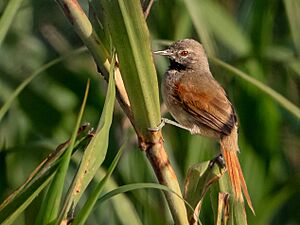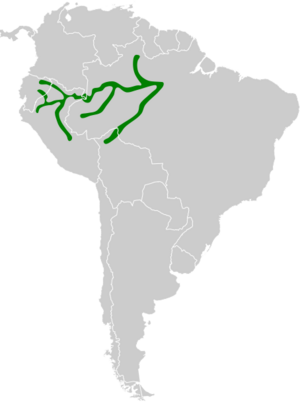White-bellied spinetail facts for kids
Quick facts for kids White-bellied spinetail |
|
|---|---|
 |
|
| Conservation status | |
| Scientific classification | |
| Genus: |
Mazaria
|
| Species: |
propinqua
|
 |
|
| Synonyms | |
|
Synallaxis propinqua |
|
The white-bellied spinetail (Mazaria propinqua) is a small bird that belongs to the ovenbird family called Furnariidae. You can find this bird in several South American countries like Bolivia, Brazil, Colombia, Ecuador, French Guiana, and Peru.
Contents
Understanding the White-bellied Spinetail's Family Tree
This bird was first placed in a different genus called Synallaxis. Scientists later used molecular phylogenetic studies to learn more about its family. They found it was not closely related to other birds in that group. Because of this, it was moved to its own special genus, Mazaria. The white-bellied spinetail is very closely related to the chotoy spinetail.
One of a Kind: No Subspecies
The white-bellied spinetail is a monotypic species. This means there are no different subspecies or variations of this bird. It is just one type.
What Does the White-bellied Spinetail Look Like?
The white-bellied spinetail is about 14.5 to 16 cm (5.7 to 6.3 in) long. It weighs around 16 to 22 g (0.56 to 0.78 oz), which is about the same as a few quarters. Both male and female birds look alike.
Feather Colors and Markings
Adult birds have grayish-brown feathers on their face and head. Their back, rump, and upper tail feathers are also grayish brown. Their flight feathers are mostly dark, with lighter, reddish-brown edges. The tail feathers are a dull reddish-brown and have pointed tips.
Their chin and upper throat can be white or black with white edges. The lower throat is black with white tips on the feathers. Their chest is gray or light brownish-gray. The belly is white, and the sides are pale brown.
Eyes, Beak, and Legs
The bird's eyes are brown. Its upper beak is black, and its lower beak is gray or light gray. The legs and feet are olive or olive-gray.
Young Birds vs. Adults
Young white-bellied spinetails look a bit different. Their underparts are whiter than adults. They do not have the black markings on their throat. Also, their wings are a yellowish-brown color instead of reddish-brown.
Where the White-bellied Spinetail Lives and Its Home
You can find the white-bellied spinetail along rivers in the western Amazon Basin. This area includes parts of southeastern Colombia, eastern Ecuador, and Peru. It also lives in northern Bolivia, southern French Guiana, and western Brazil.
Important Rivers for This Bird
Some of the major rivers where this bird lives include the Napo, Pastaza, Ucayali, and Madre de Díos. It also lives along the Jurua and Tocantins rivers.
Its Favorite Places to Live
The white-bellied spinetail prefers new plant growth on river islands. It especially likes grassy areas with scattered bushes and small trees. This bird lives in low-lying areas. It is found up to 200 m (700 ft) high in Colombia and Bolivia. In Ecuador, it can be found up to 300 m (1,000 ft) high.
White-bellied Spinetail Behavior
How They Move Around
The white-bellied spinetail seems to live on river islands all year long. Even when some islands flood during the rainy season, these birds have never been seen on the "mainland" areas.
What They Eat and How They Hunt
The white-bellied spinetail mainly eats insects. However, scientists have not studied its diet in great detail yet. It usually looks for food alone or in pairs. It picks prey from grasses, small branches, and leaves. It typically hunts within about 2 m (7 ft) of the ground. Sometimes, it also makes short flights to catch insects in the air.
Reproduction and Life Cycle
Not much is known about how the white-bellied spinetail reproduces. Scientists are still learning about its breeding habits and life cycle.
What Sounds They Make
The song of the white-bellied spinetail is a strange, low-pitched, and nasal sound. It sounds like "ch-r-r-r-r-r-r-r-r". It can also be described as a harsh, grating chatter: "djr djr-djr'djr'djr'djr'djr'djr'djr'djr'djr-djr".
Other sounds it makes include a slower, scratchy "krreenh-krreenh-hre-kre-kre-kre-kre". It also makes a low, drawn-out, raspy snarl "rrhhhhh". Sometimes it makes a dry, scratchy "gri-grrreh" or a longer, descending series of growls: "ri-gri-gri-gri-grreh".
Conservation Status: Is the White-bellied Spinetail Safe?
The IUCN (International Union for Conservation of Nature) has evaluated the white-bellied spinetail. They have listed it as a species of "Least Concern." This means it is not currently at high risk of disappearing.
Population and Threats
This bird has a large area where it lives. Its total population size is unknown, but it is believed to be stable. Scientists have not found any immediate threats to this bird. It is considered uncommon in some places and fairly common in others.
Human activities do not have a big short-term effect on the white-bellied spinetail. However, in the long run, it could be affected by widespread habitat loss. This could happen if there is a lot of deforestation or dam building in the Amazon. Climate change could also affect its habitat.


